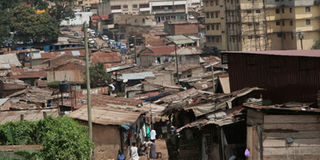Urban centres in Uganda poorly planned, says World Bank report

Ramshackle structures alongside storeyed buildings in Katanga, Kampala. In most parts of the city, slums exist alongside high end residential estates, a sign of poor planning. FILE PHOTO
Kampala. Most urban centres in Uganda are poorly planned and not productive enough to drive the country into middle income status, a report by the World Bank has revealed.
The Uganda Economic Update: The Growth Challenge: Can Ugandan Cities get to Work?” released on Tuesday, noted that urbanisation has increased across the country without clear policy coordination and planning.
Apart from Kampala, other urban centres mentioned include Wakiso, Mukono, Jinja, Soroti, Lira, Gulu, Arua, Masaka, Mbarara, Kasese and Fort Portal
“As a result, the emergence of Ugandan cities has not necessarily resulted in increased productivity, with majority of jobs created through the urbanisation process involving low productivity activities,” a summary of the report reads.
Ms Rachael Sebudde, a senior Economist at the World Bank Uganda office and co-author of the report, said economic activity in Uganda’s urban centres is focused on retail trade instead of value addition. “In cities, we should have value addition on the very commodities we trade. Instead of building an actual factory doing production for at least a shirt, to support our cotton farmers, trade in imported finished goods is thriving,” Ms Sebudde said.
According to the National Population and Household Survey 2013/14, the manufacturing sector currently employs an estimated 5 per cent of the working population.
Non agricultural jobs
As more Ugandans move to the urban areas, they are looking for more non-agricultural jobs.
However, the report indicated that most of these jobs are at micro level. It noted at least 60 per cent of the urban population stays in slum areas due to lower incomes and lack of high value jobs.
“The congestion and slums seen today in the country’s major cities are clear indications that the urbanisation process needs to be better managed in order to achieve this goal. There is a need to improve the business environment; to enhance skills; to develop infrastructure; and to provide better quality services and housing,” said Mr Philippe Director, the country director for the World Bank Group for Uganda, Tanzania and Burundi.
At the launch, government officials also agreed with the findings of the report but emphasised the need to implement what is written.
“This report will help government get a better picture and take action on how to spur the economy from the lackluster growth performance experienced over the past half-decade, to a higher growth path that can catapult the country into middle income status,” said Mr Daudi Migereko, the Minister of Lands, and Housing and Urban Development.
Vision 2040
Dr Joseph Muvawala, the executive director National Planning Authority, said in the Vision 2040, it is clearly stated how urban centers should become more productive.
The estimation is that by 2040, Uganda’s urban population will have surged to 21 million people. As they move to urban centers, the resources of local government will be strained even further. This, according to the report, could result into major slums instead of a thriving metropolis.




